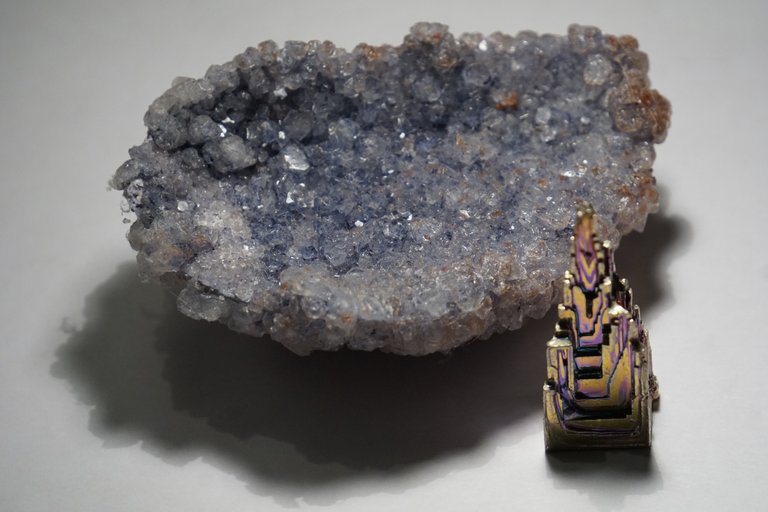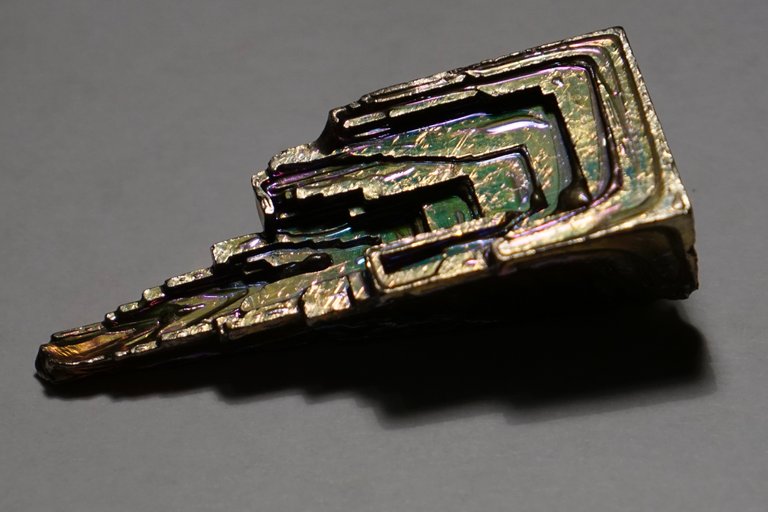The History of Synthetic Minerals
Hey dear Hive community, first of all I would like to welcome you all to my new post and hope you have a weekend that is full of positive experiences! In this post I would like to go into an interesting topic and hope you can learn something new.
Anyone who follows my contributions knows that I love to present minerals and in this article I would like to discuss the synthetic production of minerals and have photographed two specimens which have been artificially made. You can see here two different specimens of Bismuth and the blue one I even made myself a few years ago and Bismuth also occurs in nature but due to the rarity it is often produced synthetically and it is made from the supercooled melt and distinguish mainly by the appearance of natural crystals. Artificially produced minerals have almost the same chemical properties as natural ones and also the optical structure has usually the same characteristics, but it can often have a lower hardness and the history of production can already be traced back until the 19th century and already in the Middle Ages there are traces that the alchemists have done a lot of research in this area and one of the main goals of them was to artificially produce gold and some writings also appear where it was about artificially producing other minerals such as salt. Particularly interesting was the production of artificial crystals especially for industrial purposes and people quickly realized how lucrative the whole thing can be and synthetic minerals were also used to artificially create jewelry and various processes were used for the production and there is no uniform process for it.
Artificially produced gemstones had the advantage, especially from an economic point of view, that they were simply much cheaper than the natural, but also lose value faster and for collectors, natural specimens are of course particularly important and often the argument is also used that it is more environmentally friendly to produce minerals synthetically instead of making a great effort in mining. Among the best-known artificially produced species are quartz, ruby, spinel and scientists even succeeded in 20th century to artificially produce diamonds with high pressure and a few years later it was even possible to produce the first diamonds that had the quality of precious stones and in the industry artificially produced minerals are probably indispensable and are used in many different areas. Crystals are often artificially processed by the jewelry industry to change the color or the appearance and often heat is used for this and some minerals are also artificially colored and especially often you see this with minerals like Lapis Lazuli. Sometimes minerals are also artificially assembled and mixed with other substances to change the appearance and artificially enhance the product and due to these methods, which can also be packed in the drawer of artificial production, it is definitely important to always pay attention to the correct quality and trustworthiness of the mineral seller when buying.
Thank you very much for stopping by and I hope you could learn something new about minerals! I captured these pictures with my Camera Sony Alpha 6000 plus 55-210 mm lens!



https://twitter.com/lee19389/status/1736358390627246164
#hive #posh
There is so much history attached to this and I really love it that way actually
I’m glad that my contribution explains the topic well :)
Pretty good piece enhancing knowledge to me.
Happy to hear that :)
https://twitter.com/jewellery_all/status/1736495299752083616
This stone is very beautiful and its color is very different from all other stones.
They are definitely good examples of synthetic minerals :)
Yeah.
Seems like synthetic materials seems to be using all over the world right?
You’re right! It is of great importance for many industries.
https://twitter.com/adenijiadeshin7/status/1736627555619242388?t=H_l1FGuQ1AME22HtUlRUiQ&s=19
https://twitter.com/LovingGirlHive/status/1736698966815982066